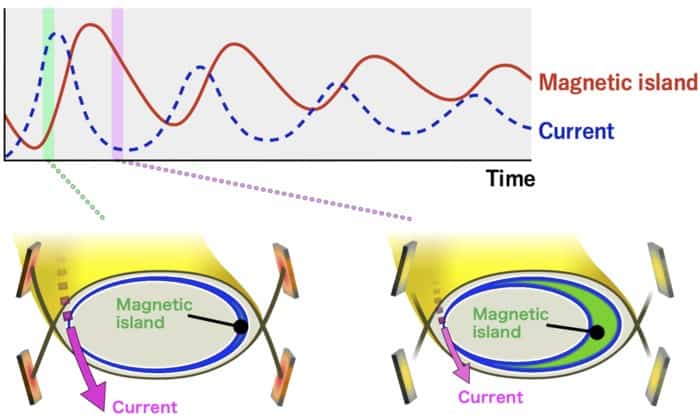
If fusion reactors are ever to provide energy commercially, they will have to operate non-stop for extended periods of time – something they are not currently able to do. Researchers in Japan report having taken a step in that direction after discovering a new kind of oscillation triggered by magnetic fields used to confine a reactor’s ultra-hot plasma. By comparing that oscillation with the fluctuating populations of predators and prey sometimes seen in nature, they reckon it should be possible to remove the variation and stably isolate the plasma.
Many physicists engaged in fusion research work on reactors known as tokamaks. These rely on a set of circular magnetic coils positioned at regular intervals around a doughnut-shaped hollow vessel to confine a plasma of light nuclei within the vessel so that the nuclei can fuse and release copious amounts of energy. The most ambitious such device is the ITER reactor currently being built in the south of France, which is designed to generate ten times the energy it consumes.
However, tokamaks have an Achilles heel – their inability to operate in a steady state. The circular coils are more closely spaced on the inside of the doughnut than they are on the outside, which causes the plasma to drift outwards. Overcoming this involves setting up a second field by using a transformer to induce a current in the plasma, but this is an inherently pulsed operation that yields energy in bursts.
Diverting heat
Reactors known as stellarators are designed to overcome this problem by using more complex-shaped magnetic coils to in effect move some of the reactor’s inner magnetic field to the outside. As such, they avoid the need for an induced current. Yet these devices – like tokamaks – still have to remove waste heat from the fusion reactions. They do this by magnetically directing plasma particles to “divertors”, which transfer the heat to cooling water. But although made from thermally-resistant materials, these components can only withstand a certain heat flux for so long before they start to degrade.
In the latest work, Tatsuya Kobayashi and colleagues at the National Institute for Fusion Science in Toki sought to limit this flux through the process of detachment. This involves neutralizing the plasma before it touches the surface of a divertor, by lowering the plasma’s local temperature enough that its constituent ions and electrons recombine. The temperature can be lowered in several ways, but in this case the idea was to use additional coils to create what are known as magnetic islands in the field close to the divertors. These cool parts of the plasma by virtue of separating them from the rest of the hot plasma.
The researchers carried out the work using the institute’s Large Helical Device, a stellarator that confines plasma along a helix. Having added ten pairs of coils to the top and bottom of the reactor, they heated and compressed deuterium gas in the reactor chamber. A little over 3.5 s into the experiment the plasma became detached from the divertors’ graphite surfaces, at which point oscillations were observed. This was a fluctuation in the size of the magnetic islands and other plasma parameters at a rate of about 40 Hz, which caused the plasma to detach and reattach at that frequency.
Predator and prey
To better understand what caused the oscillation, the researchers turned to a so-called predator-prey model. This was originally designed to explain very distinctive fluctuations in the numbers of certain pairs of animal types in the wild – in which one animal preys on the other. These fluctuations involve a repeating cycle of fairly steep rises and falls in the numbers of both prey and predator – the latter lagging slightly behind the former. The idea is that the predator depends for its survival on that one source of food, and in consuming it becomes more numerous – until the food source starts to run out. Its numbers then dwindle, allowing the prey to repopulate – and the cycle starts again.
Such models have previously been applied to other areas of science, including astronomy and indeed plasma turbulence. But Kobayashi and team found that it can also be used to explain their observed divertor oscillations. The predator in this case is the magnetic island while its prey is a “bootstrap current” set up in the plasma by the bouncing motion of confined electrons. As the current ramps up it expands the island, which increases resistivity at the edge of the island. This in turn lowers the current and causes the island to shrink. At that point the current starts to rise again, and another cycle begins.
Running the model, the researchers found what they describe as “good qualitative agreement” with the experimental results. They admit that the model may be a bit simplistic – pointing out, for example, that it yielded an oscillation frequency of only around 20 Hz. But they reckon it should be possible to bring the numbers in line by making changes such as using non-linear functions to account for the very sudden switching between detached and attached states. Once they have done that, they might then be able to use it to work out how to tune the relevant parameters so that the plasma remains detached from the divertors for extended periods without its temperature and stored energy declining.
The research is described in Physical Review Letters.



